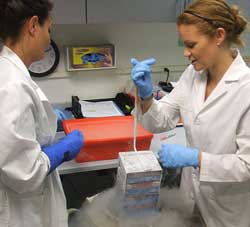|
 More and more expectant parents are banking their newborn babies’ cord blood these days. What is this new technology all about? More and more expectant parents are banking their newborn babies’ cord blood these days. What is this new technology all about?
What is Cord blood?
After a baby is delivered, the umbilical cord is clamped and cut. In the remaining cord and placenta, there is still about 100 mL of fetal blood. This “left-over” blood is called cord blood and is traditionally discarded as biological waste. However, scientists have recently discovered that cord blood is very rich in a special kind of cells called stem cells. They can be used to treat many diseases. It is therefore a real waste to discard the cord blood!
What are Stem cells?
Cord blood stem cells are powerful “master cells” that are similar to the stem cells in the bone marrow. They can continuously renew & regenerate themselves and develop into red blood cells, white blood cells, and platelets, integral components of our blood and immune systems.
What are the uses of cord blood stem cells?
Since 1988, cord blood stem cells have been increasingly used in place of bone marrow stem cells in the treatment of many diseases that require bone marrow transplantation, such as leukemia, lymphomas, and certain types of anaemia and immunodeficiency disorders. In treating these life threatening diseases, the biggest challenge traditionally was finding a matched bone marrow donor. Many patients unfortunately, may never find a donor or find one too late to be of any use. With cord blood stem cells banked, there is no worry whatsoever about finding a donor, if ever there is a need for a bone marrow transplant. The stem cells are a 100% perfect match for the cord blood donor, and can be ready in 48 hours.
Family use banking
The cord blood stem cells can also be used by other members of the family. Clinical trials have shown that chances of transplant success are very good with these stem cells. Furthermore, there is a much lower risk of “Graft versus Host Disease”, a serious complication common in transplants using unrelated bone marrow stem cells.
Cord blood versus Bone marrow
Many researchers have compared the clinical outcomes of cord blood transplant patients with those of bone marrow transplant patients. All agree that transplants using cord blood stem cells have many advantages over bone marrow. This is why in countries like Japan and the US the number of transplants using cord blood stem cells now exceeds that of bone marrow.
The only major drawback with cord blood transplants is the limited number of stem cells in each unit of cord blood. For transplants to be successful there has to be a sufficient number of donor stem cells transplanted into the recipient, and this number is determined by the body weight of the recipient. Hence it is very, very important that cord blood is collected at delivery and that as much cord blood as possible is collected.
Future potential uses of cord blood stem cells
Intense research is on-going with cord blood stem cells in regenerative medicine and tissue engineering. These stem cells may one day be used to treat many diseases other then those of the blood and immune systems, such as heart disease, diabetes, Alzheimer’s disease, Parkinson’s disease and spinal cord injuries.
Since cord blood stem cells can be cryopreserved for many years, saving a child’s cord blood today may be an important investment in his or her future health. It is not an unrealistic expectation that such advanced stem cell technology may become a reality during the lifetime of the child whose cord blood has been stored.
How is cord blood collected?
Collection is simple, painless and risk-free for mother and baby. After your baby is delivered, your doctor or midwife can collect the cord blood easily in a few minutes, using the collection kit provided by your cord blood bank. Just make sure you remember to take the collection kit to your hospital when you go into labour. The cord blood is collected in a sterile blood bag with an anticoagulant that prevents the blood from clotting, then it is transported to the bank for processing.
How long can cord blood stem cells be stored?
When cord blood stem cells are properly processed and cryopreserved at -196°C in liquid nitrogen, they should remain viable indefinitely. The only thing that may damage these cells under such circumstances is background cosmic radiation, which we are all exposed to. It is calculated that the half-life of these cryopreserved stem cells is approximately 2000 years.
Choosing a cord blood bank
There are quite a few cord blood banks in Canada. I believe all are fair and ethical and comply with basic processing standards. However, banks accredited by the American Association of Blood Banks (AABB) have more credibility because they have been objectively evaluated by an independent international organization with expertise in credentialing blood banks worldwide.
Some info: If you want to remain married to an alcoholic spouse, you must learn to raise emotional defenses in order to survive the pain of the marriage.
|